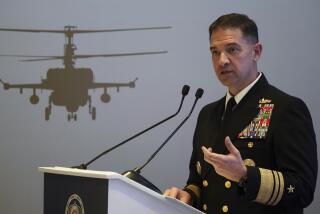3 Japanese Ships to Aid U.S.
- Share via
YOKOSUKA, Japan — Amid protests, Japanese naval vessels left for the Indian Ocean on Sunday to provide logistical support for the U.S.-led war in Afghanistan, this country’s first military deployment in a combat situation since World War II.
Three ships from the Maritime Self-Defense Force set sail under sunny skies from Yokosuka naval base just south of Tokyo and from Kure and Sasebo naval bases in southwestern Japan.
Relatives stood on the docks at Yokosuka to see their loved ones off, many waving Japanese flags as children shouted, “Daddy, bye-bye!”
A few women wiped away tears as the Uraga, a 6,300-ton minesweeper tender carrying 110 crew members, slipped out of the harbor amid a morning mist.
Protesters bearing banners reading, “The Self-Defense Forces should not be in wars!” circled the boat in a symbolic attempt to stop it.
The vessels are being sent abroad under a landmark plan approved by the Cabinet of Prime Minister Junichiro Koizumi two weeks ago. It is Japan’s first overseas deployment of its forces in a war situation in more than 55 years.
Japanese leaders are keen to avoid a rerun of Japan’s 1991 diplomatic embarrassment, when it was widely criticized for declining to commit even a token force to the Persian Gulf War. Tokyo did send minesweepers to the Gulf after the war was over.
Defense Agency chief Gen Nakatani appeared to be referring to this when he told the Uraga’s crew that its mission was an important one.
“We must aim to be a nation that is respected by the rest of the world and a nation that can act on behalf of people around the world by contributing actively and responsibly,” he said.
The three vessels--which also include the 9,100-ton supply ship Towada and the 4,000-ton destroyer Sawagiri--will join another three ships that left Japan earlier this month on an information-gathering mission.
Japan’s postwar, American-drafted constitution prohibits the use of force as a means to settle international disputes, and successive governments have interpreted that to mean a ban on collective self-defense, or aiding allies when they are attacked.
None of Japan’s four destroyers equipped with advanced Aegis radar systems, which are capable of launching more than 10 missiles at once to shoot down incoming targets, were included in the mission.
Opposition lawmakers, along with some in Koizumi’s ruling Liberal Democratic Party, had argued that including an Aegis destroyer would violate the constitution.
The decision not to dispatch one of the ships was believed to be a concession to the sensitivities of neighboring Asian nations, who suffered from Japanese actions before and during World War II and remain quick to pounce on what they see as any hints of resurgent militarism.
More to Read
Sign up for Essential California
The most important California stories and recommendations in your inbox every morning.
You may occasionally receive promotional content from the Los Angeles Times.













